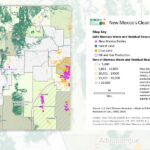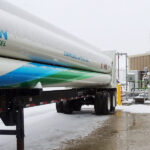
Joanna Underwood and Matthew Tomich
BioCycle October 2014
Communities across the U.S. own abundant “raw materials” for making a homegrown transportation fuel supply while virtually eliminating their contribution to climate changing greenhouse gases in a key vehicle sector. These largely overlooked raw materials are organic wastes — some 78 million tons a year of them nationwide — primarily food and yard wastes from residents and businesses that are daily carted to landfills or incinerators and sewage flushed down to sewage treatment plants. Added to the mix are livestock manures and food processing wastes.
The homegrown transportation fuel supply can be produced via anaerobic digestion of these organics. The resulting biogas can be refined into Renewable Natural Gas (RNG) for vehicles — a familiar concept to readers of BioCycle. As a vehicle fuel, compared to diesel or gasoline fuels, the California Air Resources Board found that RNG reduces carbon emissions by 90 percent or more and sometimes up to 100 percent depending on how it is produced, whereas fossil gas reduces them by 20 to 25 percent. Currently, biogas is used predominantly for power generation, mainly because of federal incentives put in place in 2005, before transportation use was considered a viable option. However, a bill recently introduced by Senator Chuck Schumer (D – New York) — the Biogas Investment Tax Credit Act of 2014 (S. 2739) — would create equal incentives for biogas used for other beneficial uses, including heat, pipeline injection and vehicle fuel. This is particularly important since, in fact, electric utilities have other renewable resources they can embrace (solar, wind, hydropower, geothermal steam, pump storage, etc.) to shift away from coal and cut their greenhouse gases. The heavy-duty transportation sector, while it can make some use of more efficient hybrid technology, has only one real alternative fuel option today: natural gas (either fossil or RNG).
Community Leadership
On the grassroots level, municipal managers can be the key game changers in launching a potentially transformational shift of their local truck and bus fleets to RNG and gaining the maximum greenhouse gas (GHG) reduction benefits. Local elected officials, agencies, companies, utilities, institutions, and citizen groups are the natural leaders because, first and foremost, all organic wastes are “local.” They are heavy and costly to haul, so it is most economical to convert them to fuel close to their point of generation. Second, cities, towns and counties already own, lease or contract for large numbers of trucks and buses that they can shift, or require to be shifted, to natural gas technology capable of benefiting from local RNG production. Third, centralized local fueling stations could then potentially serve nearly two-thirds of all the trucks and buses in the U.S. — those that travel distances of 50 miles or less from their home bases. These more than six million vehicles consume about 13 billion gallons of diesel fuel a year. If local fuel markets are not available, the fuel can be sent through the country’s extensive natural gas pipeline system to gas stations elsewhere in the country. The four million other heavy-duty vehicles on U.S. roadways are those large long-haul tractor-trailers that travel interstate highways and transport products equivalent to 70 percent of GDP. Heavy-duty natural gas engines for these most demanding vehicles are just being commercialized, and companies, including California-based Clean Energy and Utah-based Trillium, are building refueling stations, with a goal of delivering either fossil or renewable gas across the country’s interstate highways to accommodate these vehicles.
Connections To Climate March
The recent People’s Climate March and United Nations (UN) Climate Summit in New York City sounded the alarm for communities to act. The March, which galvanized almost 400,000 Americans of all ages, races and walks of life, and the Climate Summit that followed the March, spoke of a new level of commitment to stemming the global flow of GHGs that are destabilizing the world’s climate.
UN chief Ban Ki-moon, recognizing the gravity of the situation, called on heads of state attending the Summit to support an ambitious global agreement by 2015 to limit further global surface temperature increases and to enhance climate resilience. The Oil and Gas Partnership agreement released in conjunction with the UN Climate Summit also contained a commitment from 26 cities around the globe, ranging from San Francisco to Stockholm, to Rio de Janeiro and Pune, India, to draft and implement voluntary initiatives cutting GHG emissions from solid waste facilities, including landfills, and from truck fleets. This urban initiative called for expanding the number of cities to 150 by 2015, with a long-term goal of 1,000. As a country that is the second largest generator of GHGs in the world, second only to rapidly growing China, and as a country with abundant resources, the U.S. can take exemplary steps to reorient the fossil fuel based power generation systems and petroleum-based transportation systems — the two engines of growing economies — that contribute 32 percent and 28 percent of our GHG emissions respectively, to rely on renewable, and pollution- and carbon-free sources. While electric vehicles, hydrogen-powered vehicles, and more will be part of the equation, harnessing the power of our organic waste stream may be the most immediate way to make near-term progress in the transportation sector. That is because, while the total 10 million trucks and buses operating in this country make up just 4 percent of all the vehicles on our roadways, they consume 23 percent of all on-road fuel, and generate a quarter of all transportation GHGs. And the clincher is that the RNG solution for this sector is commercially available now.
What Steps To Take?
Every community, depending on its distinct population and organic waste generation rates, has the chance today to explore and take action to produce and use its own supplies of clean, renewable, low-carbon RNG fuel, partnering with the growing number of private sector firms in this new waste-based green energy and fuels sector. There may also be a chance to collaborate with other nearby waste sources (communities, agricultural operations or food processors). Whatever the case, the same project development steps are needed. These are described in a new Energy Vision guide, “Converting Organic Waste into Vehicle Fuel: A Step-by-Step Guide for Communities,” funded in part by the U.S. Department of Energy (link in online version). The Guide’s goal is to show towns, municipalities and counties their power as game changers for sustainable transportation in their roles as managers of wastes, owners of fleets, and contractors of services. The Guide also aims to draw the attention of the general public and policy makers to a sustainable transportation solution that deserves broad local, state and federal support because of the many benefits it delivers. The accompanying box highlights the six steps to move RNG projects from conception to completion. Communities and corporations, as the primary “game changers,” can be sure of one thing. Every fleet converted to RNG will exceed the national goal of a 20 percent reduction in GHG emissions from the 2005 baseline by 2020, and will actually exceed the national long-term goal of an 80 percent GHG reduction by 2050! Shifting their fleets from diesel to RNG fuel will also immediately exceed the goals called for by the group of distinguished scientists worldwide that are part of the Intergovernmental Panel on Climate Change. It’s a remarkable opportunity just waiting to be seized. Now seems the right time to seize it.
Joanna Underwood is President of Energy Vision, which she founded in 2007 to explore and promote the fuels and technologies that could move the U.S. most rapidly toward a sustainable transportation future. She was a pioneer in this country’s environmental movement, having lead another nonprofit, INFORM, for 30 years. Matthew Tomich is Vice President of Energy Vision, where his focus has been on advancement of renewable natural gas (RNG) made from a variety of organic waste sources as a vehicle fuel.











